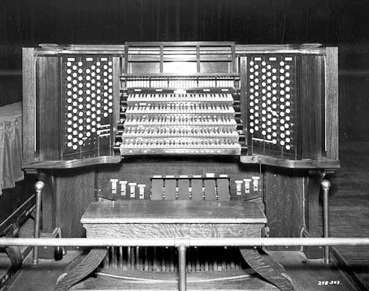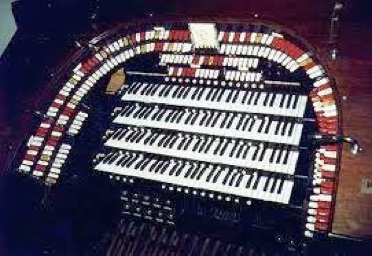|
Builder: Kimball Organ Co (Opus 7030, 1928) Manuals: Theater console - 4; Classic console - 5 Stops: 116 Ranks: 121 + 1 Action: Electro-pneumatic Notes: When the old Minneapolis Auditorium was torn down the organ was put in storage to be installed in the new Convention Center. It is partially assembled, with no money to complete it. The instrument was played from two consoles: a five-manual classic console and a four-manual theater console. This is the specification is from the classic console. This organ is actually two organs, a V/121 concert organ and a IV/24 unit theatre organ. The 24 ranks of the theatre organ consist of the unit stops in the classic specification. A single rank -- Kinura -- is playable only from the theater console. Thus the total organ has 122 ranks, although it is not possible to play all 122 from either console. Two mixture stops by M.P. Möller were added in 1957. At this time the 64' was disconnected and the Great 5-1/3' also disappeared -- either disconnected or moved to another pitch. When the auditorium was demolished in 1987, plans called for the instrument to be reinstalled in the new convention center. This is not an ideal space, but was the only place available at the time owned by the City and large enough to hold this massive instrument. The project was delayed due to financial issues and was never finished. The organ remains in situ in its chambers, safely stored at the Minneapolis Convention Center. It is partially assembled, although there is no wind supply, no electrical system, no swell shades, no bottom boards. The blower is connected electrically and some pipes are standing on their chests. As of 2017, rough estimate for completion is $2,000,000. The organ was dedicated by Lynwood Farnum & Eddy Dunsteader. Note that all three 32' stops are full length and there is no stopped 32'. --Information from The American Municipal Pipe Organ Website. --Photos from a brochure provided by Ronald S. Crowl. -- More information is available on the TCAGO website under "Voice of Minneapolis", including many more pictures of the building and the chambers. Mill City Times Further information and pictures |
 |
 |
|
|
GREAT ORGAN 16 Double Open Diapason 16 Bourdon 8 First Open Diapason 8 Second Open Diapason 8 Third Open Diapason 8 Fourth Open Diapason 8 Melophone 8 Doppel Flute 8 Viola 8 Gemshorn 8 Gemshorn Celeste 4 First Octave 4 Second Octave 4 Third Octave 4 Hohl Flute 2-2/3 Twelfth 2 Fifteenth 1-3/5 Seventeenth 1-1/3 Nineteenth 1-1/7 Septime 1 Twenty-Second II Rauschquinte III Cymbel V Mixture 16 Double Trombone 8 Tromba 8 Trumpet 4 Clarion Reed Tremolo Tremolo SW, CH, SOLO couplers at 16, 8, and 4 8 Chimes 8 Harp 8 Marimba SWELL ORGAN 16 Contra Viola Diapason 16 Lieblich Gedeckt 8 Diapason 8 Violin Diapason 8 Gamba Celeste 8 Salicional 8 Vox Celeste 8 Dulcet II 8 Clarabella 8 Stopped Flute 8 Harmonic Flute 8 Spitz Flute Celeste 4 Octave 4 Harmonic Flute 4 Violina 4 Celestina II 2 Flautino V Mixture IV Dolce Cornet 16 Double Trumpet 8 French Trumpet 8 Cornopean 8 Oboe 8 Vox Humana 4 Clarion Vox Vibrato Tremolo SW Unison; couplers at 16, 4 Solo coupler at 16,8,4 Choir coupler at 8 8 Harp (CH) 4 Celesta (CH) CHOIR ORGAN 16 Contra Viola 8 English Diapason 8 Geigen Principal 8 Viola 8 Concert Flute 8 Forest Flute 8 Flute Celeste 8 Muted Violin 8 Unda Maris 4 Prestant 4 Flauto Traverso 2-2/3 Nazard 2 Piccolo 1-3/5 Tierce 16 Bassoon 8 Tuba Horn 8 English Horn 8 Clarinet Tremolo CH Unison; CH couplers at 16, 4 SW couplers at 16,8,4 Solo coupler 8 8 Harp 8 Piano 4 Celesta |
BOMBARDE 16 Bombarde 8 Tuba Magna 8 Tuba 4 Clarion V Mixture 8 Chimes (GT) 8 Harp (CH) 8 Marimba Harp (GT) 8 Marimba (GT) 4 Xylophone (CH) 4 Celesta (CH) 2 Orchestral Bells (CH) 2 Glockenspiel (CH) 16 Piano 8 Piano 4 Piano PEDAL ORGAN 64 Gravissima (Resultant) 32 Double Open Diapason (open wood, behind right grill) 32 Contra Violone (open zinc, in Great/Pedal chamber) 16 Open Diapason 16 Second Open Diapason 16 Diaphone (wood basses) 16 Violone 16 Violin Diapason 16 First Bourdon 16 Second Bourdon 16 Viola 16 Gedeckt 10-2/3 Quinte 8 Diaphonic Diapason 8 Octave 8 Cello 8 Stopped Flute 8 Viole d’Orchestre 8 Flute 8 Gedeckt 5-1/3 Twelfth 4 Super Octave 4 Octave Flute 3-1/5 Tierce 2 Twenty-Second 32 Contra Bombarde (in Great/Pedal chamber) 16 Bombarde 16 Trombone 16 Ophicleide 16 Tuba 16 Basson 8 Clarion 4 Octave Clarion SW couplers 8,4 CH couplers 8,4 16 Piano 8 Piano (originally located with 32' Open Diapason) 8 Chimes SOLO ORGAN 8 Diapason Stentor 8 Tibia Clause Tibia Tremolo 8 Gross Gamba 8 Cross Gamba Celeste 8 Viole d’Orchestre 8 Violes Celeste II 8 Hohl Flute 4 Octave 4 Solo Flute 16 Tuba Profunda 8 Tuba Mirabilis 8 Tuba Sonora 8 Post Horn 8 French Horn 8 Saxophone 8 Musette 8 Orchestral Oboe 8 Solo Vox Humana 4 Clarion Vox Vibrato Tremolo Solo Unison; couplers 16,8,4 Great coupler 8 Swell couplers 16,8,4 8 Chimes (GT) 8 Harp (CH) Percussions and traps for the theater organ are in the Great/Pedal chamber. The Great/Pedal chamber was double the height of the other chambers, holding two 32' ranks and many of the 16's. It was on the left side of the stage. The small Bombarde chamber was above the Great/Pedal. The Swell, Solo and Choir chambers were on the right side of the stage. All chambers were very deep, with shutters at the narrow end to speak through the stage grills. |
| There were heroic efforts to keep this huge, aging electro-pneumatic behemoth working in its final years. The 5-manual classic console was disconnected and a 4-manual console was wired in temporarily. This console was used for all of the final concerts prior to disassembly. | The Moller addition was a small exposed wind chest in front of the Great/Pedal chamber shutters, but behind the grill so it was not visible. This chest held the Great mixtures. The Cymbel, in particular, had a hard, steely sound, very much out of character with the grand, opulent sound of the rest of the organ. |
 |